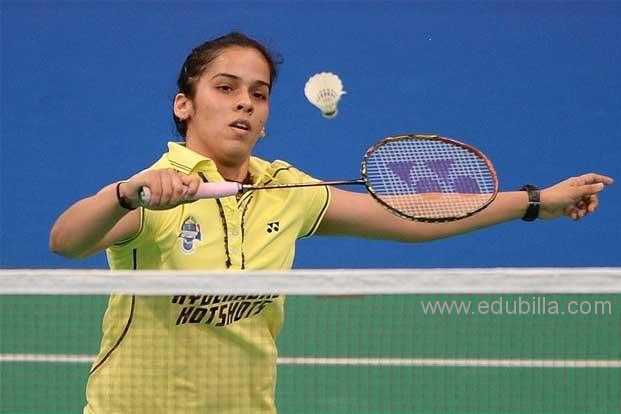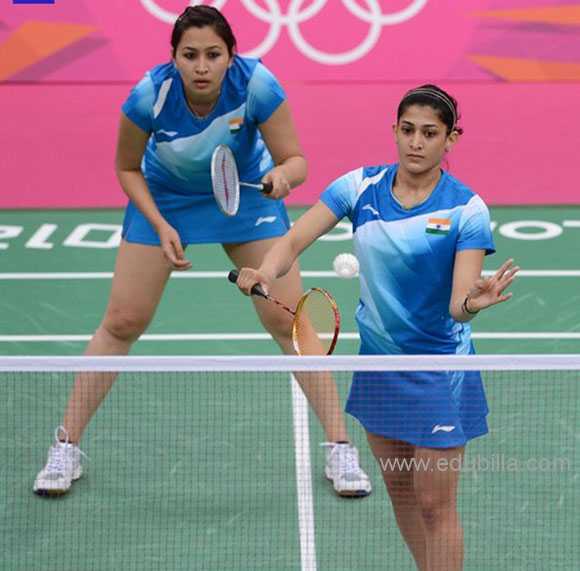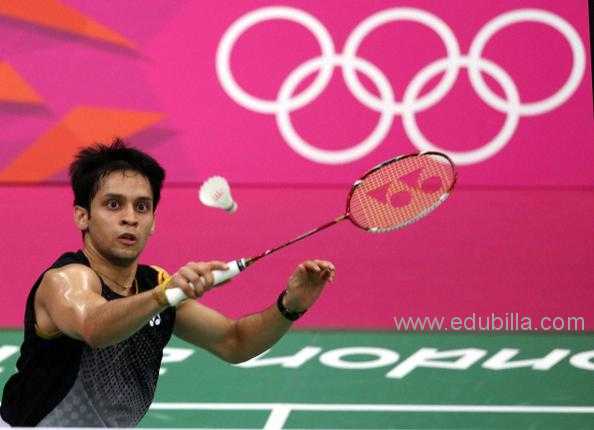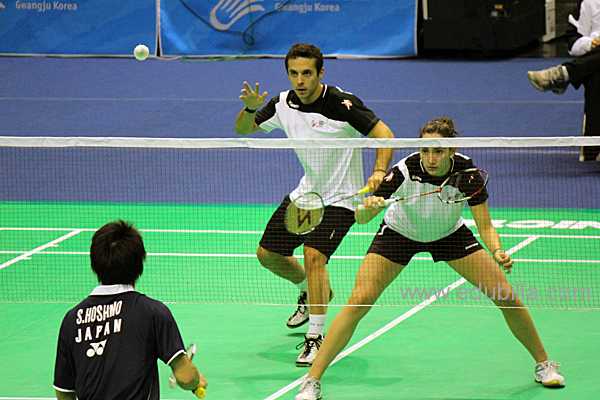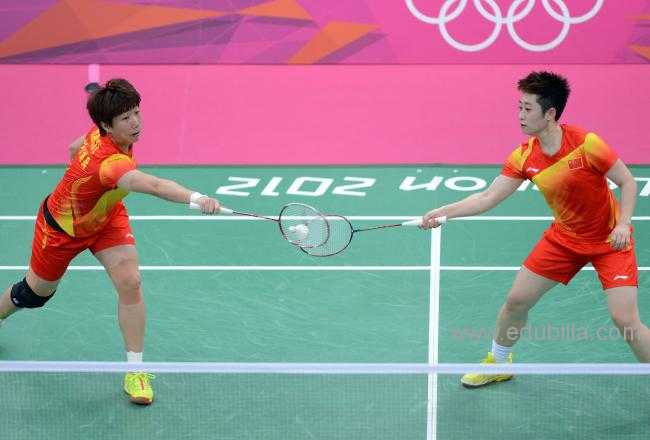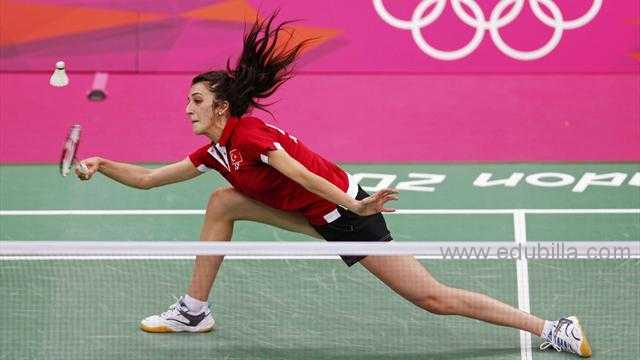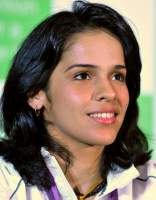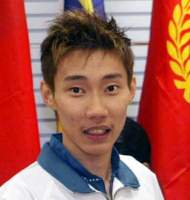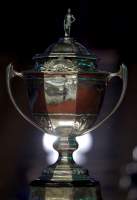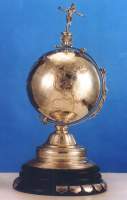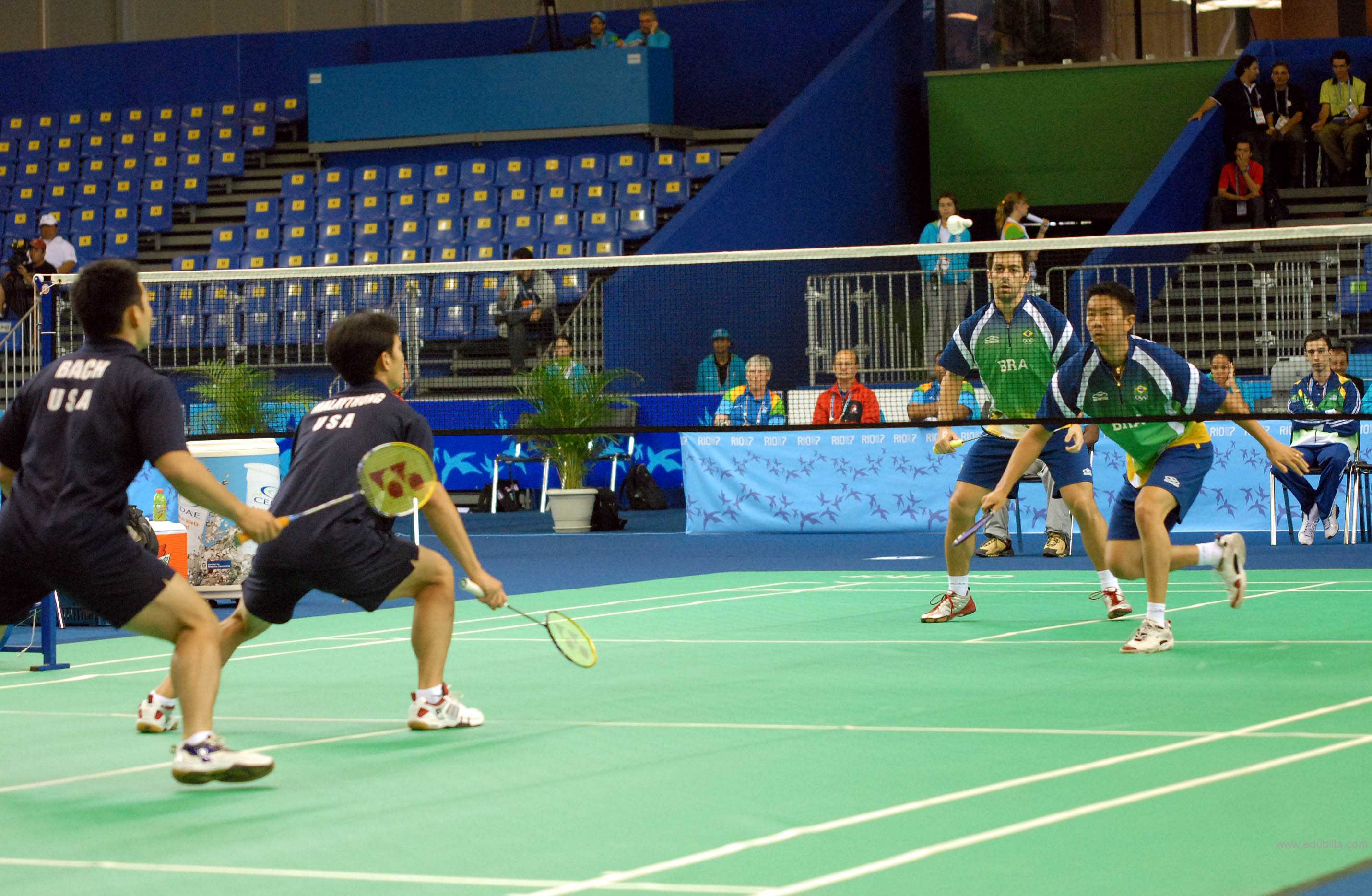
Overview Of Badminton
Badminton is a racquet sport played by either two opposing players (singles) or two opposing pairs (doubles), who take positions on opposite halves of a rectangular court divided by a net. Players score points by striking a shuttlecock with their racquet so that it passes over the net and lands in their opponents' half of the court. Each side may only strike the shuttlecock once before it passes over the net. A rally ends once the shuttlecock has struck the floor, or if a fault has been called by either the umpire or service judge or, in their absence, the offending player, at any time during the rally.
The shuttlecock is a feathered or (mainly in noncompetitive matches) plastic projectile whose unique aerodynamic properties cause it to fly differently from the balls used in most racquet sports; in particular, the feathers create much higher drag, causing the shuttlecock to decelerate more rapidly than a ball. Shuttlecocks have a much higher top speed, when compared to other racquet sports. Because shuttlecock flight is affected by wind, competitive badminton is played indoors. Badminton is also played outdoors as a casual recreational activity, often as a garden or beach game.
Since 1992, badminton has been an Olympic sport with five events: men's and women's singles, men's and women's doubles, and mixed doubles, in which each pair consists of a man and a woman. At high levels of play, especially in singles, the sport demands excellent fitness: players require aerobic stamina, agility, explosive strength, speed and precision. It is also a technical sport, requiring good motor coordination and the development of sophisticated racquet movements
Badminton in India:
Badminton is a popular sport in India. It is the second most played sport in India after Cricket.Badminton in India is managed by Badminton Association of India.
Indian "shuttler" Saina Nehwal was ranked second in the world in the year 2010.Prakash Padukone and Pullela Gopichand, both won the All England Open in 1980 and 2001 respectively.Saina is also the lone Indian badminton player to have won an Olympic medal when she won the bronze medal at the 2012 Olympics.
The league has 6 franchises representing different Indian cities and attracts many international players.
Game Rules
Scoring System:
A match consists of the best of 3 games of 21 points.
Every time there is a serve – there is a point scored.
The side winning a rally adds a point to its score.
At 20 all, the side which gains a 2 point lead first, wins that game.
At 29 all, the side scoring the 30th point, wins that game.
The side winning a game serves first in the next game.
Interval and Change of Ends:
When the leading score reaches 11 points, players have a 60 second interval.
A 2 minute interval between each game is allowed.
In the third game, players change ends when the leading score reaches 11 points.
Singles:
At the beginning of the game (0-0) and when the server’s score is even, the server serves from the right service court. When the server’s score is odd, the server serves from the left service court.
If the server wins a rally, the server scores a point and then serves again from the alternate service court.
If the receiver wins a rally, the receiver scores a point and becomes the new server. They serve from the appropriate service court – left if their score is odd, and right if it is even.
Doubles:
A side has only one ‘service’.
The service passes consecutively to the players as shown in the diagram.
At the beginning of the game and when the score is even, the server serves from the right service court. When it is odd, the server serves from the left court.
If the serving side wins a rally, the serving side scores a point and the same server serves again from the alternate service court.
If the receiving side wins a rally, the receiving side scores a point. The receiving side becomes the new serving side.
The players do not change their respective service courts until they win a point when their side is serving.
Detailed badminton Rules Can Be Downloaded From Documents
Equipments Need For Badminton
Badminton Rackets:
Modern Badminton Rackets are light in weight and usually below 100 grams. The frame of the Racket can be made of steel, aluminum, carbon fiber, ceramic, boron or a combination of some of these.It shall not exceed 680mm in overall length and 230 mm in overall width.
So how to choose a Badminton Racket that suits you most?With so many selections out there, indeed it can be very confusing. Let me share with you my experience in choosing one...Don't be overly economical. The lower priced rackets are usually quite heavy because they are made of cheaper material. You will tend to use more arm movements rather than your wrist to hit the shuttle if your wrist muscle is not strong enough.
Shuttlecock:
A Shuttlecock shall have 16 feathers fixed in a cork base covered in kid leather. Interestingly, the best Badminton Shuttlecocks are made from feathers from the left wing of a goose.
The feathers shall be measured from the tip to the top of the base and each shuttle shall be of the same length. This length can be between 62mm and 70mm. The shuttle shall weigh between 4.74 to 5.50 grams.
Shuttles are usually graded according to speed. If you have reached a certain level and can hit from baseline to baseline, use standard speed shuttlecocks. If your strength is not there yet, you can use shuttlecocks of a slightly faster speed.
Badminton String:
Choosing the right Badminton String to go with your racket is important. It may win you games when playing against opponent of similar standard.First, you have to know that there are two types of Badminton Strings, strings made of natural guts material or synthetic material.
Natural guts strings provide more feel, control and power. It gives out less vibration and is nice to play with. However, they are less durable and more expensive.Unless you have a higher budget, you may want to use the synthetic ones.
Badminton Strings have different gauge numbers to indicate the thickness or diameter of the strings. Thicker strings will have a lower gauge number. A 20 gauge string is thicker than a 22 gauge one.
Badminton Shoes:
A good pair of Badminton Shoes must provide good grip, cushioning and some flexibility at the forefoot.Never wear jogging shoes to play badminton. These shoes have thicker soles and lack the stability needed for badminton. You might end up twisting your ankles.
If you want to get a good grip from your badminton shoes, only wear it on badminton courts. Do not wear it for jogging or any other activities. Once the grip is gone, the shoes will not be effective on court anymore.
Badminton Accessory:
In this Badminton Accessory category, I have grouped five items under it. They are Grip, Badminton Clothes, Socks, Wrist Band and Head Band.
Badminton Clothes:
Always wear shirts and shorts that are comfortable and will not hinder your movements. I usually wear a cotton round-neck or a collar t-shirts with a pair of light shorts.
Badminton is a game with much cardiovascular activity. So there will always be a lot of sweat. Usually a normal cotton t-shirt will do well to absorb your sweat, but you can always go for a more fancy shirt that does it better.
A track suit is useful too, so that you can warm up before play and cool down gradually afterwards.
Socks:
Wear a pair of thick cotton socks as they help to absorb sweat. It will prevent your feet from slipping inside your shoes. Nylon socks can stretch and provide good fit but are not suitable for badminton as they can't absorb much sweat.
Wrist Band:
If you are those that perspire a lot, consider getting a wrist band. It will prevent your sweat from flowing to your racket handle.
Head Band:
Wear a Head Band if you are wearing spectacles. It will prevent your lenses from getting wet. Head Bands will also stop the sweat from getting into your eyes.
History Of Badminton
In the 5th century BC, the people in china then played a game called ti jian zi. A direct translation from this word 'ti jian zi' is kicking the shuttle. As the name suggest, the objective of the game is to keep the shuttle from hitting the ground without using hand. Whether this sport has anything to do with the History of Badminton is up for debate. It was however the first game that uses a Shuttle.
Etymology:
About five centuries later, a game named Battledore and Shuttlecock was played in china, Japan, India and Greece. This is a game where you use the Battledore (a paddle) to hit the Shuttlecock back and forth. By the 16th century, it has become a popular game among children in England. In Europe this game was known as jeu de volant to them. In the 1860s, a game named Poona was played in India. This game is much like the Battledore and Shuttlecock but with an added net. The British army learned this game in India and took the equipments back to England during the 1870s.
In 1873, the Duke of Beaufort held a lawn party in his country place, Badminton. A game of Poona was played on that day and became popular among the British society's elite. The new party sport became known as "the Badminton game". In 1877, the Bath Badminton Club was formed and developed the first official set of rules.
First Set of Rules:
As early as 1875, veterans returning from India started a club in Folkestone. Until 1887, the sport was played in England under the rules that prevailed in British India. The Bath Badminton Club standardized the rules and made the game applicable to English ideas. J.H.E. Hart drew up revised basic regulations in 1887 and, with Bagnel Wild, again in 1890.In 1893, the Badminton Association of England published the first set of rules according to these regulations, similar to today's rules, and officially launched badminton in a house called "Dunbar" at 6 Waverley Grove, Portsmouth, England on 13 September of that year.They also started the All England Open Badminton Championships, the first badminton competition in the world, in 1899.
Origin Of Badminton
The beginnings of badminton can be traced to the mid-1800s in British India, where it was created by British military officers stationed there.Early photographs show Englishmen adding a net to the traditional English game of battledore and shuttlecock. The sport is related to ball badminton, which originated in Tamil Nadu, and is similar to Hanetsuki which originated in Japan. Being particularly popular in the British garrison town Poona (now Pune), the game also came to be known as Poona.Initially, balls of wool referred as ball badminton were preferred by the upper classes in windy or wet conditions, but ultimately the shuttlecock stuck. This game was taken by retired officers back to England where it developed and rules were set out.
First Badminton played:
An 1863 article in The Cornhill Magazine describes badminton as "battledore and shuttlecock played with sides, across a string suspended some five feet from the ground".This early use has cast doubt on the origin through expatriates in India, though it is known that it was popular there in the 1870s and that the first rules were drawn up in Poonah in 1873.Another source cites that it was in 1877 at Karachi in (British) India, where the first attempt was made to form a set of rules.
Contemporary Badminton:
A contemporary form of badminton - a game called ‘Poon’, was played in India in the 1800s where a net was introduced and players hit the shuttlecock across the net. British officers in the mid 1800’s took this game back to England and it was introduced as a game for the guests of the Duke of Beaufort at his stately home ‘Badminton’ in Gloucestershire, England where it became popular.
First Open Tournament:
In March 1898, the first Open Tournament was held at Guildford the first 'All England' Championships were held the following year. Denmark, the USA and Canada became ardent followers of the game during the 1930s.
Governing Bodies
Badminton World Federation(BWF)):
The Badminton World Federation (BWF) is recognized by the International Olympic Committee (IOC) as the world governing body for the sport of badminton.
IBF Established in 1934:
In 1934, the International Badminton Federation was formed, with the initial members including England, Wales, Ireland, Scotland, Denmark, Holland, Canada, New Zealand and France, with India joining as an affiliate in 1936.
First IBF Tournament:
The first major IBF tournament was the Thomas Cup (world men's team championships) in 1948. Since then, the number of world events has increased with the addition of the Uber Cup (women’s team), World Championships (individual events), Sudirman Cup (mixed team), World Junior Championships and the World Grand Prix Finals.
Vision:
Badminton is a global sport accessible to all - a leading sport in participation, fan experience and media coverage.
Mission:
To lead and inspire all stakeholders, deliver world class events and innovative development initiatives to ensure badminton becomes a leading global sport.
Goals:
Key goals for the BWF are to:
- publish and promote the BWF Statutes and Principles
- encourage the formation of new Members, strengthen the bonds between Members and resolve disputes between Members.
- control and regulate the game, from an international perspective, in all countries and continents.
- promote and popularize badminton worldwide.
- support and encourage the development of badminton as a sport for all.
- organize, conduct and present world class badminton events.
- maintain an Anti-Doping Programme and ensure compliance with the WADA Code.
To Visit BWF Click Here
Awards Related To Badminton
The BWF has a system of awards that recognises excellence, achievement and service to the sport and to the badminton community. The system of awards is governed by the Awards Regulations which detail each award, the selection criteria and the process for nomination. The awards are listed below and are linked to the names of recipients for each award.
All award nominations must be received by the Chief Operating Officer no later than 31 October each year. These will be reviewed by the Awards Commission and recommendations are then made to the Administration and then finally to Council at its November / December meeting.
1. Lifetime Achievement Award
The Lifetime Achievement Award is a highly prestigious award given by the BWF to recognize individuals who have made a significant and lifetime contribution towards the advancement and promotion of the sport worldwide. Factors considered in the selection process include:
-Span and scope of contribution
-Legacy of the nominee’s contribution/work
-Additional awards / honors received
This special award is presented for outstanding contributions to the development of the sport. The award is for those who have retired after a lifetime of service in the sport. Nominees can be a player, administrator or any individual from the sport. Past recipients of any other BWF award or honour are able to be nominated for this award.
2. Hall of Fame
The BWF Hall of Fame is to honour players and administrators who have enhanced their sport through exceptional achievements. Nominees are members of the badminton fraternity who have retired from the sport of badminton for a period of five years or more. Only in special circumstances will the Administration Committee consider a recommendation to Council of a nominee who is still involved in badminton.
3. Herbert Scheele Trophy
The Herbert Scheele Trophy is presented by Council for outstanding and exceptional services to badminton. Recipients of this award are presented with a replica of the trophy Herbert Scheele Trophy.
4. Distinguished Service Award
The Distinguished Service Award is presented by Council, on behalf of the members of the BWF, in recognition of long and/or distinguished service to badminton throughout the world. The award is in the form of a certificate and lapel badge.
Serving members of Council are not eligible to be nominated. Service should be exceptional, involving more than the routine holding of office and/or participation in competitions and winning of trophies.
5. Meritorious Service Award
The President of the Badminton World Federation presents a Meritorious Service Award in recognition of long and meritorious service to badminton. The award is in the form of a certificate and lapel badge. Nominations are made by Member Associations. In the case of internationally-recognised umpires, the Technical Committee may make up to two nominations per year. Serving members of Council are not eligible to be nominated.
The number of awards available to Member Associations is based on the number of members in the Association.
6. Certificate of Commendation
A Certificate of Commendation shall be awarded, where appropriate, to commercial undertakings and other external organisations that have rendered significant service to the sport for no less than three years. Badminton clubs and other sporting bodies (eg National Olympic Committees) are not eligible to be nominated for a Certificate of Commendation.
7. Eddy Choong Player of the Year Award
This award was discontinued in 2007 and has become the Eddy Choong Most Promising Player of the Year Award - see below.
8. Annual Players Award
-Best Male Player of the Year
-Best Female Player of the Year
-Eddy Choong Most Promising Player of the Year
This criteria is based on the performance of the players in the Super Series events and major BWF tournaments which are the World Championships, the Sudirman Cup and the Thomas/Uber Cup.
9. Women in Badminton Award
The Women in Badminton Award recognises an individual (man or woman) or an organisation that has made a significant contribution towards the involvement of women or girls in badminton.
Key selection criteria are:
-A strong advocate for women or girls in badminton
-Significant contribution for women or girls in badminton
10. President's Medal
The President's Medal is to honour distinguished individuals or organisations who have made an exceptional contribution to badminton. Nominations are made exclusively by the BWF President.
Key selection criteria:
-Exceptional contribution to badminton
-Exceptional achievements for international badminton
Sample Documents Of Badminton
-Sachin Tendulkar


